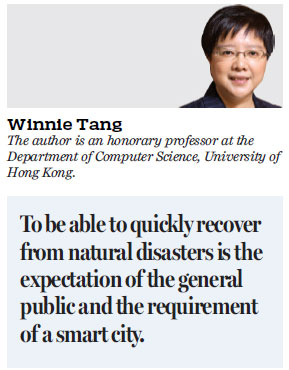A central information platform will boost govt decision making
Updated: 2018-10-10 08:01
(HK Edition)
|
|||||||
The public was infuriated by the traffic chaos as they went to work the day after Super Typhoon Mangkhut hit the city last month. Many people had to wait for hours before they could get on a public transport vehicle as service on many bus routes and some MTR lines was suspended due to facility damage caused by the typhoon. Many employees struggled to complete their journeys to work and then again on their way home. The government was blamed for not issuing a work suspension order.
One might hope that this super typhoon was a one-off event which would not happen again. But climatologists around the world are predicting violent storms, like the fearsome Mangkhut this year and Hato last year, will become the new norm due to global warming.
Further, future occurrences of a similar scale of disruption such as breakdown of electricity supply or water supply cannot be ruled out. Therefore, there is a genuine need for upgraded preparation systems.

First of all, it is imperative that coordination among all parties, including the government, public-services sectors and citizens, should be improved and strengthened so as to make the best use of our resources and make right decisions at the crucial time.
To enable this, collecting, processing and predicting all emergency requests and available information - whether it comes from hotline numbers 999 and 1823, the police, fire department or front-line staff - by a common platform integrated with the latest updates on service suspensions of buses and the MTR, is essential for the government to make better decisions.
We need a centralized real-time geographic information system (GIS) platform or a Common Operational Picture (COP) to coordinate recovery at the time of disaster and beyond. All the reported incidents should be shown on a single and interactive map. In case the government needs to evacuate residents, the map can show the capacity and number of vacancies of shelters in the neighborhood. The optimal route will also be displayed to avoid blockage by fallen trees.
The COP has been widely used in European countries and the US. Its use in the 41-year-old Chicago Marathon is a good example. As one of the six World Marathon Majors, the race was capped at 45,000 runners, with 1.7 million spectators last year. Its route crosses 29 jurisdictions. To ensure a successful race, the event organization started to use a COP last year. Each runner was required to wear an RFID (radio frequency identification) chip so their location could be tracked and shared on a real-time map. Besides, information from various government departments and organizations, including the Chicago Police Department, the Federal Bureau of Investigation, the Federal Emergency Management Agency, the Department of Homeland Security, the Illinois State Police, together with that from fire and emergency medical service, nonprofits, and thousands of CCTV cameras throughout the city were all integrated and accessible on the map to provide overall situational real-time awareness. The COP helped to locate the runners, all organizing personnel and their belongings. This facilitated the frontline workers having a common and current understanding of the race status.
At the same time, COP could consolidate all relevant information from different parties so that everyone involved in rescue operations was aware of their workloads, manpower and equipment resources required for disaster response duties. It could serve as a platform for coordination and command, allowing commanders to keep abreast on the latest and comprehensive relief situation, issue orders and allocate resources. With this GIS tool, the disaster relief team can perform its duties to save lives and property with maximum efficiency.
While the government was blamed for the traffic chaos after the typhoon, the international flight service which would have borne the brunt of the situation did not draw much media attention. The reason is that the Hong Kong International Airport responded quickly in the early morning of the next day, and rescheduled around 2,000 flights within 48 hours after the typhoon was gone. That was, on average, a flight of every 1.44 minutes. Behind the speedy recovery and smooth operation, GIS was one of the key solutions in its support. It enabled coordination among departments within the Airport Authority so that the management could master the situation and make the best decisions based on the data and spatial analysis.
To be able to quickly recover from natural disasters is the expectation of the general public and the requirement of a smart city.
(HK Edition 10/10/2018 page8)